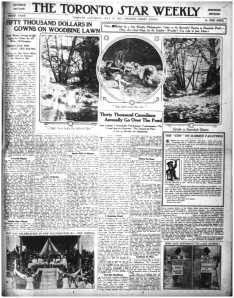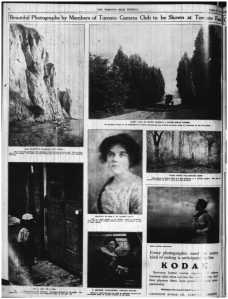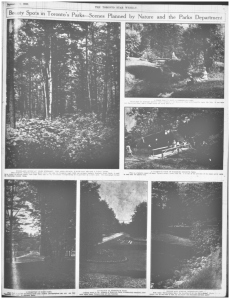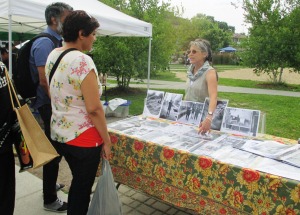Making Pictures
 Kodak Canada Corporate Archives and Collection
Kodak Canada Corporate Archives and Collection
The rise in leisure and popularity of outdoor sports prompted Kodak to introduce the first folding pocket camera in 1898. The light-weight, point-and-shoot design was marketed as an essential tool, a fashion accessory and supplement to sports equipment. The summer 1913 ads for the Premo camera represented it as a conduit to nature for the consumer. The suggestion was also that, at the other end of the lens, the seasonally changing landscape was custom-made for photography.
All outdoors invites your KODAK, The Toronto Star Weekly, June 14, 1913 p. 4
"Every call of the open is a call to KODAK" The Toronto Star Weekly, June 28, 1913 p. 4
Kodak opened a Canadian distribution operation here in 1899 following reports of the Toronto market’s strength. Beyond promoting photography as a way to enhance one’s encounter with nature, the company linked it to the equally ennobling hobby of art making. By 1913 Kodak was organizing a Toronto week-long festival around an exhibition that highlighted photography’s cultural status.

 excerpts from Kodak Trade Circular, Toronto 1913 Kodak Canada Corporate Archives and Collection, Ryerson University
excerpts from Kodak Trade Circular, Toronto 1913 Kodak Canada Corporate Archives and Collection, Ryerson University
The Daily Star ran summer amateur photography competitions to promote its weekend supplement. With an offer of cash prizes and promise of publication of their work, readers were invited to send images on such seasonal themes as, “Canadians at their summer homes ” and “pretty girls in summer resorts”. The most repeated year-round picture theme was “Beauty Spots around Toronto”, expressed through professional and amateur views of well-known landscapes and parks.
 The Toronto Star Weekly, May 31, 1913
The Toronto Star Weekly, May 31, 1913
Reading Pictures
By the first decades of the twentieth century the look of newspapers had radically changed. Faster presses, the power to reproduce photographs and a desire to appeal to a mass audience tipped the balance of the content and design from text dominated columns of “hard news” to illustrated human interest stories. Seeking ways to distinguish themselves from their competitors city dailies searched for ways to involve their readers in the life of the streets, parks and other public spaces.
Photographs of events, people and places were brought together in weekend pictorial supplements. In full-page photo lay-outs of The Toronto Star Weekly, the close-to-home items were juxtaposed with “news of the world” photographic tidbits offering a smorgasbord of topical images.
 On page 4 of the January 11, 1913 edition of the Toronto Star Weekly, a photo of the latest Parisian chapeaux the “airplane hat” in which a feather at the back evokes a propeller, is juxtaposed with a cigar-smoking family in the Philippine Islands. Above these items are two views of the Don River with a caption lamenting its polluted state and highlighting the river’s importance as a feature of Riverdale Park.
On page 4 of the January 11, 1913 edition of the Toronto Star Weekly, a photo of the latest Parisian chapeaux the “airplane hat” in which a feather at the back evokes a propeller, is juxtaposed with a cigar-smoking family in the Philippine Islands. Above these items are two views of the Don River with a caption lamenting its polluted state and highlighting the river’s importance as a feature of Riverdale Park.
BEAUTIFUL BY NATURE, MARRED BY COMMERCE AND CARELESSNESS. The west bank of the Don River at Riverdale Park. Out in the country the Don is beautiful, in Torontoit is dirtier and uglier than seems necessary. HOW EASILY THIS MIGHT BEMADE A BEAUTY SPOT! The east bank of the Don at Riverdale Park. Thereis more than a suggestion of beauty here despite the ugly decayed piling. How different if nature had a chance!
The Toronto Camera Club on View
Through its weekend edition The Star revealed the problems of Toronto as a modern metropolis as well as the flip side of the picture, the natural beauty accessible to its residents. It highlighted the power of the ordinary citizen to move back and forth between city and country by showcasing the work of amateur photographers. The Toronto Camera Club members’ art photography, especially landscapes, were featured at the beginning of the summer and at its close in advance of the same work being shown at the Canadian National Exhibition.
 The Toronto Star Weekly, June 8, 1912
The Toronto Star Weekly, June 8, 1912
BEAUTY SPOTS AROUND TORONTO A CHARMING WOODLAND DRIVE IN THE SPRING TIME This beautiful study of a country roadway was made by one of the clever amateurs of the Toronto Camera Club. The Toronto Star Weekly, June 8, 1912
 “Beautiful Photographs by Members of Toronto Camera Club to be Shown at The Fair”, Toronto Star Weekly Aug. 9, 1913
“Beautiful Photographs by Members of Toronto Camera Club to be Shown at The Fair”, Toronto Star Weekly Aug. 9, 1913
The Push for Parks
Publishing landscapes of its own freelance professional photographers, The Daily Star visually defined the spectrum of park types within the city and surrounding districts. These ranged from the formally planted, pebble- path Victorian style park exemplified by Allan Gardens and Reservoir and Riverdale Parks, to scenic driveways such as the Rosedale ravine to the English Romantic landscape park tradition embodied in High Park.
 “Beauty Spots in Toronto’s Parks–Scenes Planned by Nature and the Toronto Parks Department” The Toronto Star Weekly Sept. 7, 1912
“Beauty Spots in Toronto’s Parks–Scenes Planned by Nature and the Toronto Parks Department” The Toronto Star Weekly Sept. 7, 1912
"Beauty Spots..." detail, The Toronto Star Weekly, Sept. 7, 1912 John Boyd Sr., City of Toronto Archives, Fonds 1548 Series 393
Toronto’s penny-pinching politicians had been slow to acquire land for parks and by the years before the First World War were under pressure to buy the few remaining large estates on the city outskirts. Neatly bringing together the contemporary enthusiasm for photography as art with the popular lobby for park land purchase, The Daily Star joined in the chorus demanding council to invest before it was too late.
WOODLAND SCENE AT "GLEN STEWART," THE AMES ESTATE WHICH MAY BECOME A PUBLIC PARK. This property, situated between Queen street east and the Kingston road (with the entrance opposite Scarboro Beach Park is said to be richer in natural beauty than High park and the City of Toronto is negotiating its purchase asa public park. The photograph reveals the charming wooded vistas.
 “Beautiful Properties for Purchase of Which the City of Toronto Has Been Negotiating” Toronto Star Weekly Aug. 17, 1912 p3
“Beautiful Properties for Purchase of Which the City of Toronto Has Been Negotiating” Toronto Star Weekly Aug. 17, 1912 p3
Contact with nature was seen as pivotal to the health and well being of the population; the park movement in North America that began in the nineteenth century was given impetus by casual snapshots as well as art photography of everyday people. By publishing photos as a testimony to healthy and ennobling civic engagement with open spaces, The Star gave moral weight to the argument that particularly beautiful, “unspoiled” places should be enshrined as parks .
In 1912 Glen Stewart estate was represented, through the pages of The Star as the natural endowment of Torontonians. The property, a private estate park with winding drives and paths similar to High Park, according to the newspaper, had the makings of an ideal city park. Through sympathetic landscaping by city crews and citizen landscape photography, nature would be found there in its ideal form.
Pictures Submitted in The Star Weekly’s Prize Competition for Amateur Photographers July 26, 1913 p1





